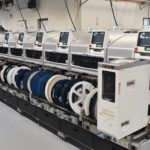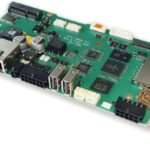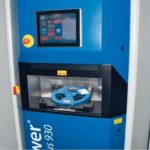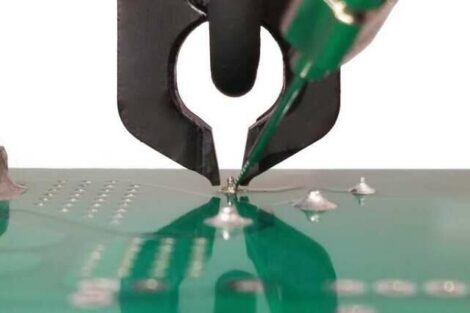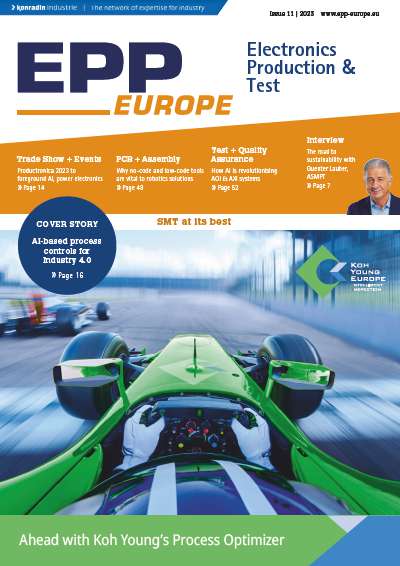Surface-mounted device (SMD) is a method of mounting electrical component directly onto the surface of a PCB, as opposed to through-hole, which takes up space on both sides of a board. This technology allows for smaller devices and tighter component placement. It is utilized on embedded systems and human machine interfaces (HMIs), which has made the Garz & Fricke Group one of the European market leaders in its segment. The circuit boards are designed and manufactured in-house. The various electronic components such as resistors, capacitors, integrated circuits (IC) for specific tasks such as WLAN or Bluetooth, and connectors for inputs and outputs are placed on these boards. The assembly is done by a special machine – the pick and place machine – as part of the SMD production line.
During the years of using the existing machines, disadvantages such as the two-sided and partly non-ergonomic operation became obvious. Above all, however, they were no longer state-of-the-art and could not handle the current tiny sizes of the electronic components.
Another important reason: ”The old production line consisted of different generations of machines that were about to reach their final EOL. This meant that support would be discontinued soon,“ explains Christian Gillmann. For Garz & Fricke, which produces around 250,000 boards per year, this was a no-go. Due to the end of support for the machine, the availability of spare parts wasn’t ensured anymore, which meant that in worst case, a longer-term downtime could occur. At the end of 2017, it was clear that a new machine was needed. Gillmann and his colleagues screened the market. Relatively quickly, the choice fell on the Japanese manufacturer Fuji and its “NXT III“ – a modular pick and place machine.
Excursion: the operation of a pick and place machine
In pick and place machines, a conveyor belt runs in the center of the machine, where the circuit board or the so-called blank lies. According to the pre-programmed coordinates X, Y and Z as well as a defined rotation angle, the components are placed in an already applied solder paste. They are fed via special belts, blisters in technical jargon. These rolls with the blister belts look a bit like a classic film roll.
The feeders are then used: They pull the components into the machine via the belt and place them in a defined position. Special placement heads, mini robots inside the machine, use suction to grab a component and place it precisely on the board. With older machines, such as the one that was replaced at the company, employees then had to check whether everything was set up correctly using the dual control principle. Modern systems, such as the Fuji NXT III, check themselves via integrated high-resolution cameras and image recognition to ensure correct component placement.
Pick and place machine in operation
Thanks to the NXT III, the Garz & Fricke Group can now mount even the smallest components, down to 0.25 mm x 0.125 mm. Odd-shape components, on the other hand, are considerably larger and represent a particular challenge. These components are larger, measuring up to 50 mm x 30 mm x 25 mm, and are often hooked into the board. An example is the classic RJ45 jack, as they are standard on every single board computer from the company. As they are plugged into the board, a barb is compressed and snaps open when properly placed. The component is then firmly anchored. However, the system must apply a certain pressure for this process, known as the cogging torque, which the old system was not able to do reliably. Christian Gillmann describes, ”Setting such components caused problems on the old line from time to time.“ With the new line, he says, cogging is now unproblematic. ”That means we can apply defined forces with the system up to a certain point. Fuji has confirmed that the heads are designed for this. On the old system, loading with these mechanically held components was at our own risk.“
Family setups
The Fuji NXT III in Hamburg works precisely and reliably while enabling implementation of long-awaited production concepts, including the family setups. The machine is equipped throughout with the most frequently used components – after all, there are around 140 different SMD items on the company’s average board, from resistors to connectors. On average, 720 placement positions are set for a flat assembly with the NXT III. Operators can add individual or special elements for each board. This allows Garz & Fricke to supply customized solutions with more flexibility on the basis of a modular system. „Before we switched to the new system, we sometimes had days when we only manufactured one side of a board. We couldn‘t pass on finished single board computers to the following process such as testing,“ explains Gillmann, ”Now we can break batches down into smaller runs, allowing us to build and test in one shift.“ The next day, the boards are already available for assembly. With a turnaround time of one day in flat-board production, they can provide customers within a short time. „That was one of the main tasks, and the new line can do that.“
Small batch capabilities
At the same time, small batches can now be produced, which wasn‘t previously possible in terms of batch size. This small batch production is possible by continuous production. The Fuji NXT III can seamlessly switch the program for the board to be produced. While board A is still being assembled in the rear part, the boards for board B can already be fed in at the front. The transition between the boards is seamless. Gillmann stated, ”This is something new on the machine, which we also demanded via the specifications. It‘s called a seamless changeover.“
Production on the machine also runs seamlessly with regard to reloading blister rolls that have run out. If the stock of a component runs low, the operator receives information such as ”Component XY will be empty in six minutes“ on screens above the machine. This allows the operator to prepare the next roll and be on time with it at the machine. If the machine is loaded with different blister rolls, there is now only a minimum of production downtime. If all assembly stations are not in use, the new roll with components can be inserted directly into one of the empty stations during production. The solution then seamlessly switches from one blister roll to the other, avoiding a production downtime completely.
The new pick and place machine gives operators more freedom thanks to smart networking. The machine not only displays messages and warnings on the mentioned screens, but also sends the information directly to the operator. The operator wears a smart watch on his wrist and is notified of incoming messages from the machine by vibration.
Modular, expandable, future-proof
The SMD line with its pick and place machine currently extends over 18 meters in length and has a modular design. This means that the line can be easily modified by Garz & Fricke technicians. Modules can be removed and integrated into other production lines. The current installation can also be continuously expanded.
The placement heads inside the system are as flexible as the system. If their performance is no longer sufficient, a head of this type can be easily swapped for a more powerful one. It is also possible to use heads with special capabilities such as adhesive heads that apply SMD adhesive. The exchange is possible from production to production, allowing the company to adapt the machine to new needs in the future.
One aspect that convinced Christian Gillmann is the compatibility of the different series. Modules from the current ”NXT III“ series can be integrated into older ”NXT II“ type systems. ”When Fuji launches the ‚NXT IV‘ version, we can be sure that we will be able to combine our model III with it.“
Another difference to the old system is the design. Whereas the operators had to travel to both long sides of the old system to check and reload blister rolls, the new system keeps everything on just one side. This means that the operator only has to monitor a six-and-a-half-meter front. The line can also be positioned closer to the wall of the hall, which creates space for additional machines and options.
Blister rollers are also positioned higher on the NXT III. The increased ergonomics mean that the operator no longer has to bend down to place a roll in the appropriate holder. This is important with regard to demographic change, as Christian Gillmann emphasizes: ”This was decisive for us, because you have to be able to work well on the line, even if you are older.“
The design also ensures easy maintenance. This means that heads are quickly replaced not only in the event of a change in configuration, but also in the event of a fault. ”In just ten minutes, the exchange is completed,“ explains Gillmann, ”This brings a very high level of safety.“ He underlines, ”The exchange can be carried out by our own technicians. Fuji only needs to supply the head.” In general, the manufacturer provides its customers with everything they need to have more autonomy: Detailed maintenance instructions and specifications on equipment service intervals. Garz & Fricke can even carry out repairs or annual maintenance on their own.
Fuji is also one of the few to supply maintenance tools. This refers, for example, to a machine for cleaning the placement heads. The head is hooked into this machine and then automatically rinsed and cleaned. Gillmann: ”Fuji is really unique with this.“
Handling and support
After a good three years of planning and implementation, Garz & Fricke is also convinced of Fuji‘s handling and support. Gillmann reports that plans and specifications were modified during the two-year planning phase: ”Fuji always listened to us and implemented our suggestions. They also provided valuable input in terms of best practices to help us optimize our systems and workflow. They supported us along the way to build the most efficient new SMD line possible.”
After completion of the planning, the structured procedure on the part of Fuji remained in place. They advised on IT matters and supported Garz & Fricke during the roll-out of the necessary software. ”That means we didn‘t lose that time,“ Christian Gillmann recalls, ”When the line was set up here, we were already equipped and could say the information technology part was probably running at 99 percent.“
The Hamburg team was satisfied when the new system was delivered. In advance, the manufacturer sent detailed information about the packaging of the solution. Gillmann: ”We knew at all times not only how big the case was. We also knew which forklift was needed and what load it had to lift. That can actually cause problems when delivering machines if you don‘t get those details. Fuji did an excellent job of providing it to us.“ A service technician was also on hand to help throughout the installation, even during the first days of production when the employees had questions.
Christian Gillmann is pleased with the communication with Fuji. Communication with Japan was managed by Fuji Europe. ”When we had requests for the software, these were also implemented – once even within just two weeks, including import into our systems. That‘s quite unique when a Japanese manufacturer directly implements such requirements to a German company – simply because electronics production is mainly focused on the Asian market.“
Future prospects
Garz & Fricke now sees itself well equipped for the years ahead. After all, the specialist guarantees that the single board computers will be available for a decade. This and the shortest possible delivery times are assured. In addition, the pick and place machine enables a new type of traceability of the components used. The company can document production all the way down to the individual blister roll. In the event of a damaged component, they can now ensure traceability down to the assembly level.
Conclusion: a successful future
Excellent support from planning to commissioning, high operator and maintenance friendliness, flexibility and sustainable operation – Garz & Fricke is satisfied with its decision. Already in 2020, they have been able to run approximately 30 percent more production batches through the system and thus supply more customers. As planned, the embedded specialist has been able to reduce throughput times, explains Christian Gillmann: ”If we used to finish a batch within a week, we can now do it in a day.“
Fuji Europe Corporation GmbH
Fujiallee 4
65451 Kelsterbach, Germany
Tel.: +49 6107 6842–0
E-Mail: fec_info@fuji-euro.de
Website: www.fuji-euro.de
Garz & Fricke GmbH
Schlachthofstraße 20
21079 Hamburg, Germany
Tel.: +49 40 79189930
E-Mail: info@garz-fricke.com
Website: www.garz-fricke.com
Ein Embedded-Spezialist erneuerte in den vergangenen Monaten Teile seiner SMD-Fertigungslinie und arbeitete dabei eng mit einem Hersteller von SMD-Bestückungsautomaten zusammen, um eine modulare, präzise und wartungsfreundliche Lösung zu erhalten.
Au cours des derniers mois, un spécialiste intégré a renouvelé certaines parties de sa ligne de fabrication SMD et a collaboré, dans ce cadre, étroitement avec un fabricant d’automates d’assemblage SMD pour trouver une solution modulaire, précise avec une maintenance aisée.
За последние месяцы специалист в области встраиваемых систем обновил части своей производственной линии SMD, работая в тесном сотрудничестве с производителем оборудования для монтажа компонентов SMD. В результате было реализовано модульное, точное и простое в обслуживании решение.


